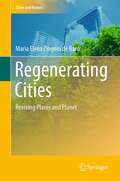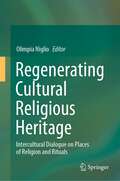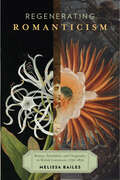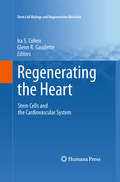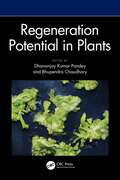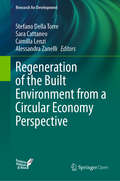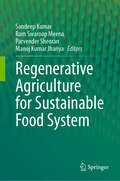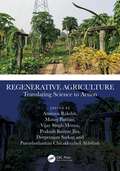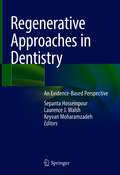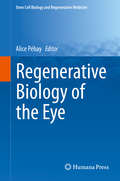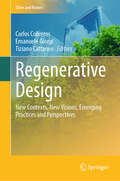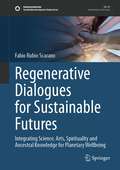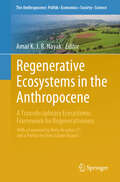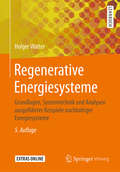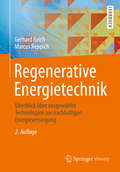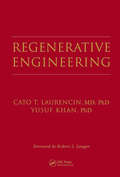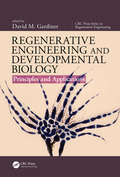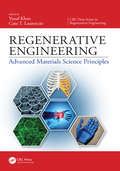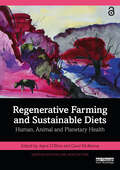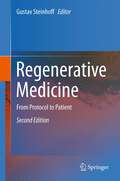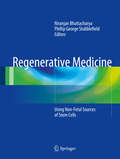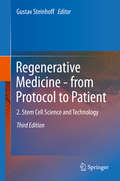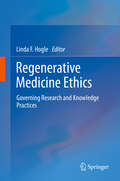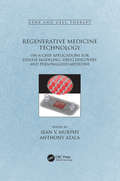- Table View
- List View
Regenerating Cities: Reviving Places and Planet (Cities and Nature)
by Maria Elena Zingoni de BaroThis book sets out the discussion on how cities can contribute solutions to some of the challenges the urbanised world is facing, such as the pressure of growing populations, mitigation of effects of, and adaptation to globally changing environmental, climate and public health conditions. Presenting a detailed explanation of the causes behind the current state of modern cities, the book advocates for a paradigm shift to improve the quality of life of ever-increasing urban inhabitants whilst nourishing the natural systems that sustain human and non-human life in the planet. Recognising the precious role that nature plays in the functioning of cities, it delves into the study of biophilic design and regenerative development. The book argues that these social-ecological design approaches can act as catalysts to develop conditions in urban settings that are beneficial for natural and human systems to thrive and flourish, both in ecosystem services and social-cultural systems. This is particularly relevant for the design of new quality precincts or the regeneration of degraded urban spaces to promote health, wellbeing and urban resilience. A framework is proposed to guide the process of thinking about, designing and building healthier, more liveable and resilient urban environments that raise the quality of life in cities. The method can be used by researchers, practitioners -urban designers, urban planners, architects and landscape architects- interested in developing their work within a social-ecological perspective. It can also be used by local governments and agencies to underpin policy making, and by educational institutions to prepare graduates with necessary skills to respond to current and future built environment challenges.
Regenerating Cultural Religious Heritage: Intercultural Dialogue on Places of Religion and Rituals
by Olimpia NiglioThis book introduces important reflections on understanding the meaning of cultural-religious heritage in an international context and their relationship with issues of sustainability at the local community level. Through a holistic approach, the book charts new courses in analyzing different cultural policies and methods for preserving and enhancing cultural heritage. Stemming from an intercultural seminar promoted by the International Scientific Committee Places of Religion and Ritual (ICOMOS PRERICO) under the theme of “Reuse and regenerations of cultural-religious heritage in the world: Comparison among cultures,” the book examines the scientific diplomacy and cultural strategies promoted by countries in dialogue with the UN 2030 Agenda, as well as Agenda 21 for Culture. The book seeks to reinforce the value of local cultural policies for supporting and enhancing cultural-religious heritage through specific programs and collaborations in dialogue with government policies. This collection is relevant to scholars working in areas relating to cultural heritage, religious heritage, architectural restoration, protection of the local inheritances, law, and management of the cultural sites.
Regenerating Romanticism: Botany, Sensibility, and Originality in British Literature, 1750–1830
by Melissa BailesWithin key texts of Romantic-era aesthetics, William Wordsworth, S. T. Coleridge, and other writers and theorists pointed to the poet, naturalist, and physician Erasmus Darwin as exemplifying a lack of originality and sensibility in the period’s scientific literature--the very qualities that such literature had actually sought to achieve. The success of this strawman tactic in establishing Romantic-era principles resulted in the historical devaluation of numerous other, especially female, imaginative authors, creating misunderstandings about the aesthetic intentions of the period’s scientific literature that continue to hinder and mislead scholars even today. Regenerating Romanticism demonstrates that such strategies enabled some literary critics and arbiters of Romantic-era aesthetics to portray literature and science as locked in competition with one another while also establishing standards for the literary canon that mirrored developing ideas of scientific or biological sexism and racism. With this groundbreaking study, Melissa Bailes renovates understandings of sensibility and its importance to the late eighteenth- and early nineteenth-century movement of scientific literature within genres such as poetry, novels, travel writing, children’s literature, and literary criticism that obviously and technically engage with the natural sciences.
Regenerating the Heart
by Glenn R. Gaudette Ira S. CohenMedical research made huge strides in treating heart disease in the 20th century, from drug-eluding stents to automatic internal defibrillators. Public awareness of the dangers of heart disease has never been more pervasive. Now, though, ten years into a new millennium, scientists are gearing up for the next great challenges in tackling this pervasive condition. Cell therapy is going to be a key weapon in the fight against heart disease. It has the potential to address many cardiovascular conditions. From heart failure to atrioventricular nodal dysfunction, the young but promising field of cell therapy is set to play a significant role in developing the cures that the upcoming decades of hard work will yield. Regenerating the Heart: Stem Cells and the Cardiovascular System organizes the field into a digestible body of knowledge. Its four sections cover mechanical regeneration, electrical regeneration, cardiac tissues and in vivo stem cell therapies. An array of talented researchers share the fruits of their labors, with chapters covering such crucial issues as the cardiogenic potential of varying stem cell types, the ways in which they might be used to tackle arrhythmias, their possible application to biological replacements for cardiac tissues such as valves, and the varying approaches used in the in vivo evaluation of stem cell therapies, including methods of delivering stem cells to the myocardium. This comprehensive survey of an area of research with such exciting potential is an invaluable resource both for veteran stem cell researchers who need to monitor fresh developments, and for newly minted investigators seeking inspirational examples.
Regeneration Potential in Plants
by Dhananjay Kumar Pandey Bhupendra ChaudharyRegeneration Potential in Plants delves into the intricate world of plant regeneration, exploring the biological and molecular mechanisms that enable plants to regenerate under different conditions. This book offers an authoritative perspective on one of the most fascinating and vital processes in plant biology, setting a benchmark for future research and applications. Unlike other volumes that focus solely on theoretical aspects, this comprehensive work bridges the gap between foundational knowledge and practical implications, showcasing its importance in fields ranging from genetic engineering to crop improvement.Key features include: In-depth coverage of somatic embryogenesis and organogenesis as pivotal regeneration pathways. Detailed descriptions of signaling pathways, gene expression, and microRNAs involved in plant tissue regeneration. Insights into the latest biotechnological tools and techniques for enhancing plant regenerative capacities. Discussions on potential challenges and future directions in harnessing plant regeneration for sustainable development. This book is an invaluable resource for plant biologists, researchers, and graduate students aiming to deepen their understanding of plant regeneration. Additionally, agricultural scientists and biotechnology professionals will find practical insights into the applications of plant regeneration for improving crop resilience and productivity. By blending high-level academic content with real-world examples, Regeneration Potential in Plants equips readers with the knowledge and tools to contribute to this dynamic and essential area of plant science.
Regeneration of the Built Environment from a Circular Economy Perspective (Research for Development)
by Alessandra Zanelli Camilla Lenzi Stefano Della Torre Sara CattaneoThis open access book explores the strategic importance and advantages of adopting multidisciplinary and multiscalar approaches of inquiry and intervention with respect to the built environment, based on principles of sustainability and circular economy strategies. A series of key challenges are considered in depth from a multidisciplinary perspective, spanning engineering, architecture, and regional and urban economics. These challenges include strategies to relaunch socioeconomic development through regenerative processes, the regeneration of urban spaces from the perspective of resilience, the development and deployment of innovative products and processes in the construction sector in order to comply more fully with the principles of sustainability and circularity, and the development of multiscale approaches to enhance the performance of both the existing building stock and new buildings. The book offers a rich selection of conceptual, empirical, methodological, technical, and case study/project-based research. It will be of value for all who have an interest in regeneration of the built environment from a circular economy perspective.
Regenerative Agriculture for Sustainable Food Systems
by Sandeep Kumar Ram Swaroop Meena Manoj Kumar Jhariya Parvender SheoranThis book aims to present a comprehensive collection of information that combines improved soil and crop productivity, climate-based stress management, enhanced research infrastructure, financial assistance for regenerative technologies, and government subsidies and economic incentives. Considering the importance of soil biodiversity, health, and ecological balance, this book primarily focuses on effective plans and policies for soil management and restoration in agricultural soils. The book covers key areas such as advancing communication strategies to ensure subsidies and incentives for carbon-sequestering farm practices and effectively publicizing the benefits of soil carbon, health, and regenerative practices. It also includes the declaration of rules and regulations to guide policies, programs, and investments in green technologies for soil restoration and ecosystem services, and forming a robust virtual network among farmers, land managers, and their associations to prepare action plans and seek available funding for regenerative farm practices and technologies. Additionally, it promotes research and developmental activities on carbonaceous practices and land-use decisions across various agro-ecological regions and soil types. The central theme emphasizes that maintaining the ecological balance of soil, plants, the environment, and health is crucial for a healthier life and serves as a powerful tool in combating climate change, food and nutritional insecurities, and other environmental concerns. This book is suitable for teachers, researchers, scientists, government planners, policymakers, and students of agricultural sciences. It will also interest national and international climate change scientists, extension workers, and capacity builders.
Regenerative Agriculture: Translating Science to Action
by Amitava Rakshit Vijay Singh Meena Purushothaman Chirakkuzhyil Abhilash Manoj Parihar Prakash Kumar Jha Deepranjan SarkarThis book aims to focus on the current state of knowledge and scientific advances about the complex and intertwined issues of regenerative farming as a transformative solution for offsetting the disastrous climate effects of burning fossil fuels and impairments of natural resource bases. Regenerative agriculture advocates no-till practices, planting cover crops, integrating livestock and crop production, improving animal welfare practices, improving the social and economic well-being of communities, sequestering carbon, improving soil health, and increasing yields and profit with a positive impact on food access or food safety regardless of farm size.This book examines the innovations that will equip agriculture to cope with the competing challenges of addressing food and nutrition security, improving livelihoods, combatting climate change, and sustainably managing natural resources. The scope of this book extends to agricultural scientists, students, consultants, site owners, industrial stakeholders, regulators, and policymakers.
Regenerative Approaches in Dentistry: An Evidence-Based Perspective
by Keyvan Moharamzadeh Sepanta Hosseinpour Laurence J. WalshThis book provides evidence-based information in the field of regenerative dentistry discussing the most recent advances, current clinical applications, limitations and future directions. The coverage encompasses the regeneration of alveolar bone, the dentine-pulp complex, enamel, the periodontium and other tissues associated with the oral cavity. A full description is provided of regenerative approaches in dentistry including regenerative endodontics and tooth repair, regenerative periodontics, regenerative assisted orthodontics, regenerative approaches in oral medicine, and dental tissue derived stem cells and their potential applications. The book is written by an international team of leading experts. It will be beneficial for students, practitioners and researchers in the fields of endodontics, periodontics and implantology.
Regenerative Biology of the Eye
by Alice PébayThis text is a comprehensive look at the current knowledge on stem cell application for vision loss, showcasing different types of stem cells (adult, embryonic, iPSCs) for diseases of the front and the back of the eye. It also highlights data obtained in various models from fish to human, as well as from the bionic eye project for vision regeneration. This volume in the Stem Cell Biology and Regenerative Medicine series is essential reading for stem cell biologists, ophthalmologists, advanced and graduate students, in addition to academics and medical staff who work in these disciplines.
Regenerative Design: New Contexts, New Visions, Emerging Practices and Perspectives (Cities and Nature)
by Emanuele Giorgi Tiziano Cattaneo Carlos CobrerosThis book aims to provide bases for reasoning on what opportunities the regenerative approaches to urban-architectural design and development can bring to our territories and living systems (environment, society, city and learning). It collects research, experiences and considerations from experts that present innovations from different contexts, especially from the Latin-Mediterranean context. The goal of this book is to provide the reader with case studies, analysis and guidelines, resulting from scientific research from academia and practice. The book collects research focused on topics that are nowadays crucial to understand how to intervene in the complicated contexts of socio-environmental emergencies. These studies are organized into seven sections, discussing from the importance of new narrative facing future environmental challenges, to the appropriate methodologies and approaches for regenerative culture with systemic view. The book closes with outputs, dreams and hopes of regenerative design: challenges and opportunities to rewrite our alliance with the environment and to move forward our relation with the socio-environmental capital.
Regenerative Dialogues for Sustainable Futures: Integrating Science, Arts, Spirituality and Ancestral Knowledge for Planetary Wellbeing (Sustainable Development Goals Series)
by Fabio ScaranoThis book is about sustainability in its broadest sense. It argues that the ongoing science-policy dialogue on sustainable development (as framed by the United Nations’ Sustainable Development Goals) is insufficient to drive the planet to desired sustainable futures. This conversation, followed by transformative action, must be inclusive of other forms of interpretation of reality (arts, spirituality, and ancestral knowledge) and non-modern cosmovisions. This is more a book about dialogues than about the common dualism problem/solution, and such dialogues are approached as an essential trigger of regeneration. The book takes the reader from a historical perspective of the human-nature relationship through to a discussion on sustainable futures as utopias. The optimism conveyed by the book is justified by a plethora of global examples of such regenerative dialogues.
Regenerative Ecosystems in the Anthropocene: A Transdisciplinary Ecosystemic Framework for Regenerativeness (The Anthropocene: Politik—Economics—Society—Science #38)
by Amar K. J. R. NayakThe book offers a transdisciplinary eco-systemic framework for analysis of ecosystems. It uses eight dimensions (economic-social-political-environmen-tal) and 40 factors to diagnose degenerating ecosystems and to synthesize regenerative ecosystems amid growing uncertainty, and inequality in the Anthropocene. Chapter 1 broadly defines the `all interacting evolving systems science' (AIESS) approach in terms of its eco-systemic and transdisciplinary action research methodology. Chapter 2 provides a detailed explanation of the AIESS approach through the four concepts of interconnectedness, interdependence, interactions, and intent to diagnose degeneration and synthesize regenerative systems. Part 1 of the book discusses the issues and approaches to Regenerativeness. Part 2, 3, 4, and 5 illustrate cases of regenerative systems in different ecosystems viz. natural, rural-indigenous, urban, and industrial ecosystems.Not only the researchers and scholarsin systems science, systems dynamics, systems design, and sustainable transition strategies but also the policy makers, corporate leaders, and development experts will greatly benefit from this book.1. Presents a ground breaking explanation of the science of change in the Anthropocene and in epochs prior to it through its all interacting evolving systems science framework. 2. Provides a unique transdisciplinary eco-systemic framework as a methodology to diagnose the complex degenerating ecosystems and to synthesize regenerative ecosystems in different geographies of the world. 3. Through various cases from different ecosystems viz., natural ecosystems, rural-indigenous ecosystems, urban ecosystems, and industrial ecosystems, the book presents the challenges as well as the steps and processes to synthesize regenerative ecosystems.
Regenerative Energiesysteme: Grundlagen, Systemtechnik und Analysen ausgeführter Beispiele nachhaltiger Energiesysteme
by Holger WatterErneuerbare Energien und nachhaltige Energiesysteme stehen auf Grund der Klimaveränderungen im Mittelpunkt der gesellschaftlichen Diskussion. Das Ziel dieses Lehrbuches ist es, wesentliche Funktionsmechanismen wichtiger nachhaltiger Energiesysteme darzustellen, Einflussparameter zu erläutern und Potentiale durch Überschlagsrechnungen aufzuzeigen. Beispielanlagen aus der Praxis geben zuverlässige Informationen für die tägliche Arbeit, dabei liegt der Schwerpunkt auf kleinen, dezentralen Anlagen. Übungen mit Lösungen erleichtern den Zugang zu den verschiedenen Stoffgebieten. Die 5. Auflage enthält aktualisierte volkswirtschaftliche Energie- und Leistungsdaten der verschiedenen Energiesektoren, neue Abbildungen zu Aufbau und Funktion von Wasserturbinen, eine Berechnungsmethode zur Abschätzung der adiabaten Temperatur für die thermo-chemische Umwandlung, Beschreibungen zu aktuellen Projektbeispielen für „Power-to-Gas" und „Power-to-Liquid" sowie eine Einführung in die Grundlagen des Projektmanagements im Energiesektor.
Regenerative Energietechnik: Überblick Über Ausgewählte Technologien Zur Nachhaltigen Energieversorgung
by Gerhard Reich Marcus ReppichDie Energiewirtschaft wird unter Berücksichtigung der Aspekte Versorgungssicherheit, Wirtschaftlichkeit sowie Klima- und Umweltschutz in den nächsten Jahrzehnten durch umfassende Veränderungen geprägt sein. Dieses Lehrbuch beschreibt Grundlagen ausgewählter Technologien zur Nutzung regenerativer Energiequellen, denen global langfristig das größte Potenzial eingeräumt wird. Den Schwerpunkt bildet die Umwandlung der Solarstrahlung und der Windenergie. Beide Technologien stellen unverzichtbare Bestandteile einer nachhaltigen Energieversorgung dar. Weiterhin werden die Erzeugung, die Speicherung und der Transport von Wasserstoff sowie Bauarten und Anwendungen von Brennstoffzellen erläutert. Beispielaufgaben und Übungen erleichtern und vertiefen das Verständnis.
Regenerative Engineering
by Cato T. Laurencin Yusuf KhanDistinct from tissue engineering, which focuses primarily on the repair of tissues, regenerative engineering focuses on the regeneration of tissues: creating living, functional tissue that has the ability to replace organs that are dysfunctional. The challenge of working in an area like regenerative engineering lies, in part, in the breadth of info
Regenerative Engineering and Developmental Biology: Principles and Applications (CRC Press Series In Regenerative Engineering)
by David M. GardinerRegenerative Engineering and Developmental Biology: Principles and Applications examines cutting-edge developments in the field of regenerative engineering. Specific attention is given to activities that embrace the importance of integrating developmental biology and tissue engineering, and how this can move beyond repairing damage to body parts to instead regenerate tissues and organs. The text furthermore focusses on the five legs of the field of regenerative engineering, including: materials, developmental biology, stem cells, physics, and clinical translation. This book was written by leading developmental biologists; each chapter examines the processes that these biologists study and how they can be advanced by using the tools available in tissue engineering/biomaterials. Individual chapters are complete with concluding remarks and thoughts on the future of regenerative engineering. A list of references is also provided to aid the reader with further research. Ultimately, this book achieves two goals. The first encourages the biomedical community to think about how inducing regeneration is an engineering problem. The second goal highlights the discoveries with animal regeneration and how these processes can be engineered to regenerate body parts. Regenerative Engineering and Developmental Biology: Principles and Applications was written with undergraduate and graduate-level biomedical engineering students and biomedical professionals in mind.
Regenerative Engineering: Advanced Materials Science Principles (CRC Press Series In Regenerative Engineering)
by Cato T. Laurencin Yusuf KhanThis book focuses on advances made in both materials science and scaffold development techniques, paying close attention to the latest and state-of-the-art research. Chapters delve into a sweeping variety of specific materials categories, from composite materials to bioactive ceramics, exploring how these materials are specifically designed for regenerative engineering applications. Also included are unique chapters on biologically-derived scaffolding, along with 3D printing technology for regenerative engineering. Features: Covers the latest developments in advanced materials for regenerative engineering and medicine. Each chapter is written by world class researchers in various aspects of this medical technology. Provides unique coverage of biologically derived scaffolding. Includes separate chapter on how 3D printing technology is related to regenerative engineering. Includes extensive references at the end of each chapter to enhance further study.
Regenerative Farming and Sustainable Diets: Human, Animal and Planetary Health (Earthscan Food and Agriculture)
by Joyce D’Silva Carol McKennaThis book makes the case for an urgent move away from industrial agriculture towards regenerative farming and the promotion of plant-based diets.How we produce, distribute and consume food are critical issues for the health and well-being of humans, animals and the environment. In order to develop a sustainable food system, this book argues for a radical change in farming and food consumption. Containing contributions from world renowned experts, this book promotes regenerative farming as the means to preserve planetary health, establish sustainable, healthy and secure diets and safeguard the welfare of animals. Chapters discuss broad ranging issues from climate change and biodiversity conservation to animal sentience and intensive farming, and the role of financial markets and food businesses. The book concludes with chapters discussing the routes in policy and practice to transforming the food system and achieving real-world change.This book is a must read for students, scholars and policymakers interested in establishing sustainable farming and food systems, for human health, animal welfare and environmental protection.The Open Access version of this book, available at www.taylorfrancis.com, has been made available under a Creative Commons Attribution‑Non Commercial‑No Derivatives (CC‑BY‑NC‑ND) 4.0 license.
Regenerative Medicine
by Engineering National Academies of SciencesThe National Academies Press (NAP)--publisher for the National Academies--publishes more than 200 books a year offering the most authoritative views, definitive information, and groundbreaking recommendations on a wide range of topics in science, engineering, and health. Our books are unique in that they are authored by the nation's leading experts in every scientific field.
Regenerative Medicine
by Gustav SteinhoffRegenerative Medicine is a fastly emerging interdisciplinary field of research and clinical therapies on the repair, replacement or regeneration of cells, tissues or organs in congenital or acquired disease. This new field of research and clinical development focussing on stem cell science and regenerative biology is just starting to be the most fascinating and controversial medical development at the dawn of the 21st century. Viewing the great expectations to restructure and regenerate tissue, organs or organisms the current attempts of scientist and physicians are still in an early phase of development. This new textbook on "Regenerative Medicine - from protocol to patient" is aiming to explain the scientific knowledge and emerging technology as well as the clinical application in different organ systems and diseases. The international leading experts from four continents describe the latest scientific and clinical knowledge of the field of "Regenerative Medicine". The process of translating science of laboratory protocols into therapies is explained in sections on basic science, clinical translation, regulatory, ethical and industrial issues. The textbook is aiming to give the student, the researcher, the health care professional, the physician, and the patient a complete survey on the current scientific basis, therapeutical protocols, clinical translation and practised therapies in Regenerative Medicine.
Regenerative Medicine
by Niranjan Bhattacharya Phillip George StubblefieldThis book represents a major contribution to the emerging science of regenerative medicine using non-fetal sources of stem cells. The Editors, Dr Niranjan Bhattacharya and Professor Phillip Stubblefield, have brought together some of the most pre-eminent scientists working on regenerative medicine to share information on currently ongoing work in this area alongside unpublished observations that will help to shape the contours of future therapies. Regenerative Medicine: Using Non-Fetal Sources of Stem Cells discusses the potential clinical and therapeutic applications using non-fetal stem cells as well as providing instruction on the collection, isolation and characterization of stem cells from various non-fetal sources, such as menstrual blood, adipose tissue, breast milk and uprooted decidual teeth. This book will be an invaluable resource for both active researches and those entering the field. The Editors truly hope that the text will act as a stimulant to professionals and clinical scientists, who may be inspired to further the work of the pioneering scientists who have contributed to this volume.
Regenerative Medicine - from Protocol to Patient
by Gustav SteinhoffRegenerative medicine is the main field of groundbreaking medical development and therapy using knowledge from developmental and stem cell biology as well as advanced molecular and cellular techniques. This collection of volumes, Regenerative Medicine: From Protocol to Patient, aims to explain the scientific knowledge and emerging technology as well as the clinical application in different organ systems and diseases. International leading experts from all over the world describe the latest scientific and clinical knowledge of the field of regenerative medicine. The process of translating science of laboratory protocols into therapies is explained in sections on regulatory, ethical and industrial issues. The collection is organized into five volumes: (1) Biology of Tissue Regeneration, (2) Stem Cell Science and Technology, (3) Tissue Engineering, Biomaterials and Nanotechnology, (4) Regenerative Therapies I, and (5) Regenerative Therapies II. The textbook gives the student, the researcher, the health care professional, the physician and the patient a complete survey on the current scientific basis, therapeutical protocols, clinical translation and practiced therapies in regenerative medicine. Volume 3: Tissue engineering, Biomaterials and Nanotechnology focuses the development of technologies, which enable an efficient transfer of therapeutic genes and drugs exclusively to target cells and potential bioactive materials for clinical use. Principles of tissue engineering, vector technology, multifunctionalized nanoparticles, biodegradable materials, controlled release, and biointerface technology are described with regard to the development of new clinical cell technology. Imaging and targeting technologies as well as biological aspects of tissue and organ engineering are depicted.
Regenerative Medicine Ethics
by Linda F. HogleThis book puts the ethics, policy and politics of stem cells into context in a way that helps readers understand why past and current issues have developed the way they have and what the implications are for their work going forward. It also addresses emerging issues as the field progresses towards clinical and industrial uses. While there is a superabundance of material on the ethics of embryo use and questions of embryonic "personhood," there is little that covers what practicing scientists and managers need to know in order to plan and execute responsible research. Furthermore, researchers funded by the NIH are required to have ethics training as a condition of the grant. As such, this book is an essential resource to all of these pre-professional students whether they plan to move into industry, government or academia.
Regenerative Medicine Technology: On-a-Chip Applications for Disease Modeling, Drug Discovery and Personalized Medicine (Gene and Cell Therapy)
by Anthony Atala Sean V. MurphyMiniaturization in the fields of chemistry and molecular biology has resulted in the "lab-on-a-chip." Such systems are micro-fabricated devices capable of handling extremely small fluid volumes facilitating the scaling of single or multiple lab processes down to a microchip-sized format. The convergence of lab-on-a-chip technology with the field of cell biology facilitated the development of "organ-on-a-chip" systems. Such systems simulate the function of tissues and organs, having the potential to bypass some cell and animal testing methods. These technologies have generated high interest as applications for disease modeling and drug discovery. This book, edited by Drs. Sean Murphy and Anthony Atala, provides a comprehensive coverage of the technologies that have been used to develop organ-on-a-chip systems. Known leaders cover the basics to the most relevant and novel topics in the field, including micro-fabrication, 3D bio-printing, 3D cell culture techniques, biosensor design and microelectronics, micro-fluidics, data collection, and predictive analysis. The book describes specific tissue types amenable for disease modeling and drug discovery applications. Lung, liver, heart, skin and kidney "on-a-chip" technologies are included as well as a progress report on designing an entire "body-on-a-chip" system. Additionally, the book covers applications of various systems for modeling tissue-specific cancers, metastasis, and tumor microenvironments; and provides an overview of current and potential applications of these systems to disease modeling, toxicity testing, and individualized medicine.
